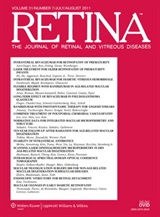L’uso della terapia fotodinamica è stato pressoché abbandonato nella terapia delle maculopatie essudative, ma conserva un’indicazione nel trattamento delle forma croniche e refrattarie della corioretinopatia sierosa centrale (CRSC).
Questo studio ha il merito di valutare la sua efficacia con uno studio controllato e randomizzato, eseguito su 34 pazienti.
I risultati visivi sono stati verificati, oltre che con misure soggettive, anche con esami elettrofunzionali, i quali permettono di valutare con accuratezza anche la sofferenza del tessuto neuroretinico.
I pazienti del gruppo trattato hanno mostrato un significativo miglioramento sia del visus, sia degli spessori medi retinici, sia dell’elettroretinogramma focale (mfERG), confermando che la PDT può trovare una utile indicazione in casi selezionati di CRSC cronicizzata.
Wu, Zenith H Y; Lai, Ricky Y K MSc; Yip, Yolanda W Y MSc; Chan, Wai Man FRCS, FRCOphth; Lam, Dennis S C MD, FRCS, FRCOphth; Lai, Timothy Y Y MD, FRCS
Retina
July/August 2011 – Volume 31 – Issue 7 – pp 1378-1386
Purpose: To evaluate retinal functional changes by multifocal electroretinography (mfERG) after photodynamic therapy with half-dose verteporfin in patients with acute central serous chorioretinopathy.
Methods: Thirty-four patients with acute central serous chorioretinopathy were randomly assigned to receive photodynamic therapy with half-dose verteporfin (n = 24) or placebo (n = 10). Multifocal electroretinography was performed at baseline and at 12 months, and serial changes in response amplitudes were expressed as amplitude ratios. The mfERG amplitude ratios, best-corrected visual acuity, and optical coherence tomography central foveal thickness were compared between the verteporfin and placebo groups. Correlation analysis between the mfERG response amplitude ratios and the best-corrected visual acuity changes and reduction in optical coherence tomography central foveal thickness were also performed.
Results: At 12 months, the mean visual improvement was 1.8 line and 0.1 line for the verteporfin and placebo groups, respectively (P = 0.003). Eyes in the verteporfin group had significantly lower central foveal thickness (P = 0.028) and higher P1 mfERG response ratios for Rings 1 and 2 at 12 months compared with the eyes in the placebo group (P = 0.030 and P = 0.018, respectively). Significant correlations between mfERG N1 and P1 amplitude ratios at the central rings were observed with both changes in best-corrected visual acuity and reductions in optical coherence tomography central foveal thickness (P < 0.05).
Conclusions: Multifocal electroretinography demonstrated higher retinal function at the central macula objectively in central serous chorioretinopathy patients treated with half-dose verteporfin photodynamic therapy. Changes in best-corrected visual acuity and optical coherence tomography central foveal thickness findings also correlated with mfERG responses of the central macula, confirming the usefulness of mfERG as an objective investigation to evaluate the functional changes in central serous chorioretinopathy.

 IMPROVEMENT IN MULTIFOCAL ELECTRORETINOGRAPHY AFTER HALF-DOSE VERTEPORFIN PHOTODYNAMIC THERAPY FOR CENTRAL SEROUS CHORIORETINOPATHY: A Randomized Placebo-Controlled Trial
IMPROVEMENT IN MULTIFOCAL ELECTRORETINOGRAPHY AFTER HALF-DOSE VERTEPORFIN PHOTODYNAMIC THERAPY FOR CENTRAL SEROUS CHORIORETINOPATHY: A Randomized Placebo-Controlled Trial